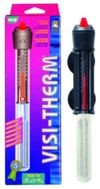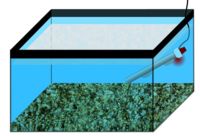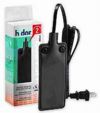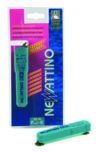Heaters
| You can contribute to the Aquarium Wiki by expanding this article. Dont be shy!. |
Heaters or 'Thermostats' are electrical pieces of equipment used to heat the water of aquariums to the desired minimum temperature.
Contents
Types available[edit]
They come in a range of sizes, most allow you to set the temperature they will shut off at. The most common type is placed into the aquarium, some are inside the external filter unit of the larger filters and some can be placed inline to the tubes feeding the external filter.
Internal heaters[edit]
These type are usually cylindrical tube shaped, have the cord permanently attached to one end and are made of glass. They usually have a dial on the end which you turn which adjusts the temperature in half or one degree.
If you have large animals in your tank then best to fit a heater guard which surrounds the tube to prevent your playful pet knocking it again the wall or a ornament and cracking it. Alternatively you can purchase metal versions made out of stainless steel or titanium. They come with two or three suckers for mounting it to the aquarium wall and a few more for attaching the cord to the glass.
- They are usually bi-metallic strip operated so there remains the slight danger of sticking on or off.
- The best method of mounting such a heater in your tank is just above the substrate and at an angle of 30-45° so that you get a water temperature gradient flowing upwards. If the heater has a indicator light on it then turn the tube so that you can see when its on. If it's too bright, then turn it so it reflects off the back wall.
External heaters[edit]
Mini heaters[edit]
This is a typical unregulated heater, made by Hydro in this example, the 7.5W heater simply heats the water continuously and thus the temperature of the water is determined by the volume of water and the surrounding air temperature. Good for small tanks between 10 and 20Litres (2.5-5 US gals) if kept at average room temperature. If you find it making the water too warm then you could plug the unit into a timer switch so it's only on every 15 minutes an hour for example.
This small 10W heater made by Underworld Products is regulated and has a fixed temperature setting of 25°C (77°F). This is designed for 12Litres (2.5 US gals) or less tanks.
Heating mats[edit]
These are primary sold to reptile or tree frog keepers but can be useful for small aquariums that require a small heat source. They are basically mats of various sizes and are a fixed power rating which you place outside the tank, usually underneath, and produce a steady heat. This can be semi-controlled by turning it off or on for preset times or simply not placing all the mat underneath.
- Note this mat can distort wood if it is in direct contact due to the heat.
- One such producer is ExoTerra and its Heat Wave devices.
Choosing a heater[edit]
Basically you choose a heater based on the size that will fit inside your aquarium tank and the amount of heat you need to raise the temperature of the water in your tank.
- Most homes are kept at ~20°C (68°F) and tropical fish are usually kept at 25°C (77°F) so companies design their heaters to raise the water temperature by 5°C (9°F). Then the size of the body of water needs to be taken into account. The larger the body, the larger the wattage required to raise the temperature by 5°C (9°F). The old rule of thumb is 5W per US gallon of water (~1W per litre) is used. So a 10 US Gallons (~50L) tank would require a 50W heater.
- Most heaters are designed to operate within 10-29°C (50-84.2°F) , if you want a higher temperature then you need a specialised heater. Try the reptile shops.
- Don't assume that a 25W heater will deliver 25W, cheap models are often build with a low accuracy and a 25W heater may be as low as ~22W.
| Litres (US gal) | 25 (6.5) | 50 (13) | 75 (20) | 100 (26) | 150 (40) | 200 (53) | 250 (66) | 300 (79) |
| +5°C (9°F) | 25W | 50W | 50W | 75W | 100W | 150W | 200W | 250W |
| +10°C (18°F) | 25W | 50W | 75W | 100W | 150W | 200W | 250W | 300W |
| +15°C (27°F) | 75W | 100W | 150W | 200W | 300W | 2x200W | 2x250W | 2x300w |
So if you have an average heated home with a room temperature of say 20°C (68°F) and you wish the water temperature of your 100 Litres (26.4US G.) tank to be 25°C (77°F) then a 75W heater is enough.
But be wary of room temperatures during the winter time, in the middle of the night during a cold spell. Your room may fall as low as 12°C (53.6°F) if you turn off the heat at night. Thus a 75W will not be enough as it only boosts the water temperature by 5°C (41°F) . So you'd need a 100W to boost it by 10°C (50°F) .
Whilst a 100 Litres (26.4US G.) tank may take 4–5 hours to fall five degrees, a lot of factors will affect this. For example the base of the tank may be on wood or on metal. There may be large air gaps around the sides of the tank which leads to higher heat dissipation or you may have a light plastic hood or a heavy all wood hood which is a better insulator.
- It is recommended that you use an electronic thermometer which has a built-in max./min. reading so you can check that the night time temperature of the water is able to be maintained during a cold spell.
Dangers[edit]
Damaged cord or device[edit]
These devices are connected directly to the mains and such carry serious risks of electrical shock to you and the pets if the cord or device is damaged.
Shorting[edit]
Most heaters operate by the use of a bimetallic strip inside the device which switches on the device when the temperature drops. It has unfortunately been too common for cheap or low quality heaters to short and therefore remain on continuously. This can cause serious damage or death to your tank occupations and therefore it is advised to do three things to reduce the risk of this.
- Buy not one heater, but two heaters, each half the required power rating. Thus if one does short, there is less risk of cooking your pets.
- Use only a good quality heater with a multi-year guarantee or warranty. Typically the Hydro or Underworld heaterstats have a consistent reputation for reliability.
- Buy a electronic heater (often called solid-state heaters) not a bimetallic sensor type. These are much more reliable and very rare for them to permanently remain on, allow a very accurate temperature setting, though can be more expensive.
Dripping water[edit]
Water damage can cause problems. As with any electrical cord that goes from the tank to the main socket you should ensure that there is a dangling loop of cord (called a drip loop) before the cord goes into the socket in the wall. This allows any water droplets to run down the cord to the lowest point and not into the socket and perhaps causing a serious danger.
Exposed heaters[edit]
Be wary of submerseable heaters that do not automatically turn off when removed from the water. It is all too easy to forget to turn off the heater when performing some tank rearranging or a water change.
Some heaters will simply turn on and due to the lack of any water will heat up to a remarkable degree and can burn your hand if touched. Also if this hot heater is splashed or quickly submerged again it can, if made of glass, very easily shatter!
Nonsubmerged heaters[edit]
A few heaters are not designed to be 100% submerged into the water. It is sometimes easy to miss this important 'feature' when buying. If these are submerged then you will damage the device.
Good features to look for:
- Electronic heat control
- Company lists temperature range the device can be set to
- Easy to set temperature dial
- Multiyear guarantee or warranty
- Generous length of cord supplied. 3+ metres is not unreasonable
- Fish guard



